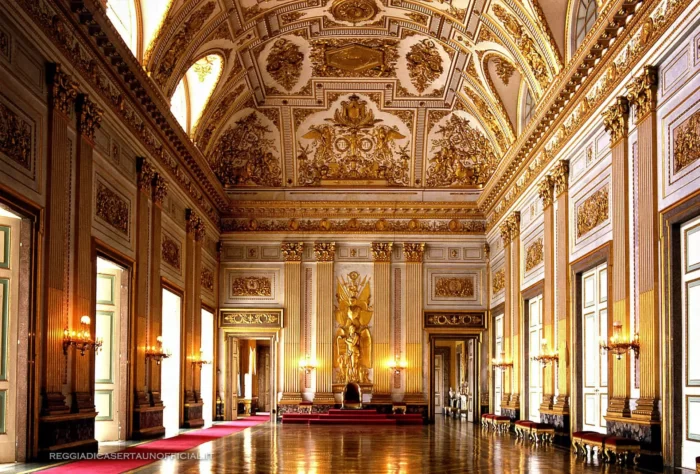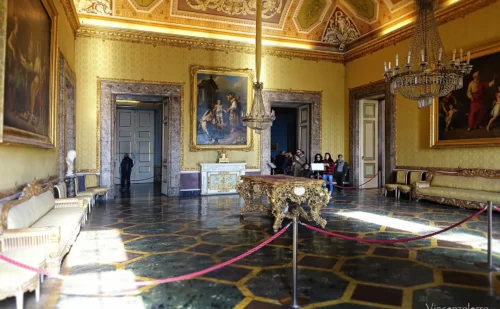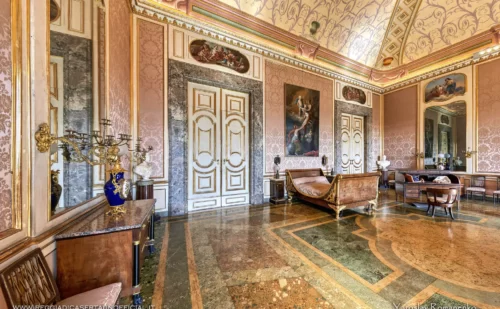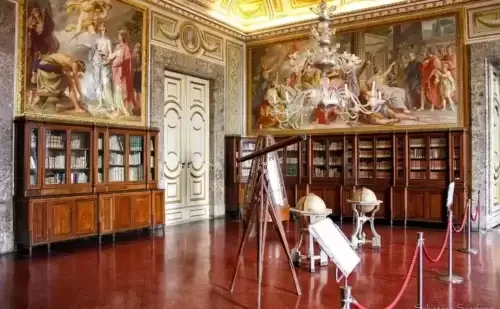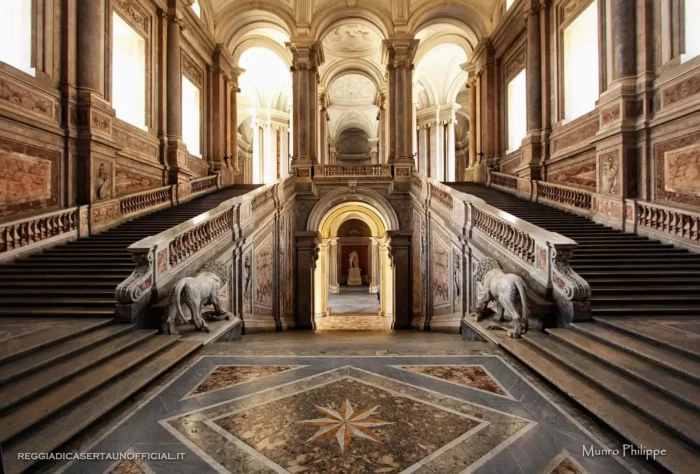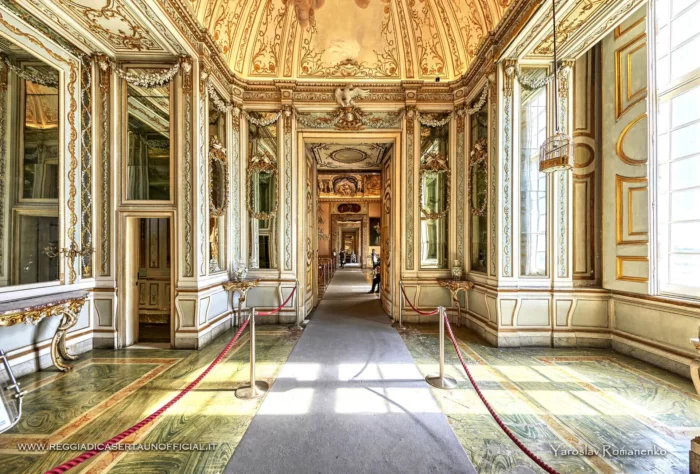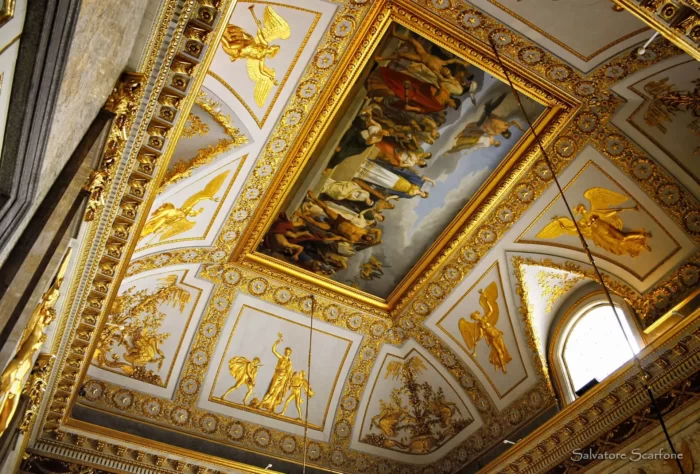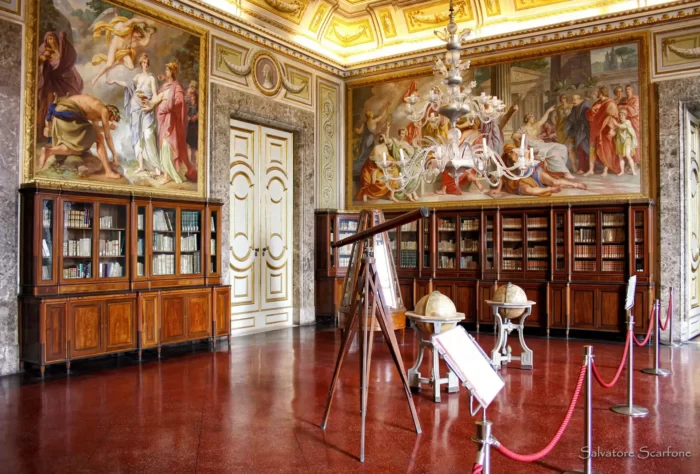The Halls of the Royal Palace of Caserta - Index page
Discover the splendid interiors of the Royal Halls and the Private Apartments of the Kings
Discover the Halls of the Royal Palace of Caserta!
History of the Halls
The Royal Floor is one of the five floors that make up the Royal Palace of Caserta (two others are underground).
The so-called “Noble Floor” in which there are the Halls and Private Rooms for the Royal Family, was divided into four areas in the original project by Vanvitelli:
- At the top left was the Queen’s Apartment, almost identical to that of the King;
- Bottom left, the King’s Apartment, part of which corresponds to the State Rooms;
- to the right were the apartments of Princes and Princesses.
The lower right area was actually the only one to be inhabited by the Royal Family for more than half a century, as the rest of the construction was not completed due to the advent of the Neapolitan Republic and the Napoleonic domination.
Royal Floor. From the “Declaration of the drawings of the Royal Palace of Caserta“
The Theater and the Palatine Chapel were the only two rooms entirely built by Luigi Vanvitelli. From 1773, the year of his death, until the end of the century, the building site of the Palace and Park was directed by his son Carlo. On the death of Luigi Vanvitelli the construction of the Royal Palace of Caserta was completed in the architectural part, but Carlo had to face the decoration problem almost completely. Certainly he did not have from the new sovereigns the influence and protection that his father had from King Charles and Queen Maria Amalia, and in times of cutting of funds, Carlo Vanvitelli performed a true miracle in being able to continue the work given the impatience of the new rulers.
In 1780 the decoration of the apartment on the east side of the facade, originally intended for the royal princes, was almost completed and King Ferdinand I wanted to go and live there during his stays in Caserta, despite the continuing work in the antechambers, which they were not ready until around 1787. Subsequently the works continued in the Napoleonic era under King Joachim Murat with the architect Antonio dei Simone and then continued on the return of the Bourbons with Gaetano Genovese who, in 1845, finished the last room, that one of the Throne .
State Apartments
Walking through the Anterooms of the Halberdiers and Bodyguards, aimed at representative functions, lighted by great chandeliers of the nineteenth century gilt bronze and decorated terracotta floor faux marble, it will reach tothe Salon of Alexander, third anteroom designed to “non-Titled”, so named by the fresco of the vault of Mariano Rossi, representing the” Marriage of Alexander the Macedonian and the oriental princess Roxane”.
The Salon of Alexander (also known as “Marble Hall”), connects the XIX and the XVIII century halls. From here on the right leads to the New Apartment, also defined as the nineteenth century Apartment in reference to the historical period in which the works of furnishing and decoration were completed, while on the left leads to the Old Apartment or XIX century Apartment. Introduced by the two Anterooms of Mars and Astrea, richly decorated with neoclassical motifs and completed during the reign of Napoleon’s , the New Apartment continues with the Throne Room.
This hall, exceeded only in size to the Grand Ballroom planned by Luigi Vanvitelli in the Apartment of the Queen, was the last to be completed and was inaugurated on the occasion of the Congress of Sciences, in 1845. More than forty meters long and lighted by six windows, in the back of the hall there is a portable throne, in gilded wood, carved and upholstered in velvet. The decoration symbolizes the absolute power; the central painting of the vault, by the Neapolitan painter Gennaro Maldarelli, portrays “The laying of the foundation stone of the Palace January 20, 1752”. Through the Council Room, will enter in the Apartment designed for the King.
EXTERNAL LINK: What is a state apartment – (collins.com)
The King's Private Rooms
The XVIII-century wing of the Palace, lived by the Bourbon court since Ferdinand IV of Bourbon, welcomes the Old Apartment: Halls in elegant Rococo taste, enriched with sumptuous San Leucio silk wallpaper, coloured chandeliers of Murano glass and paintings of the most renowned artists of the XIX century. The tour begins with the so called Seasons’ Rooms, for the presence of frescoes on the vaults representing the four seasons portrayed by Fedele Fischetti and Antonio de Dominicis.

Drawing room of King Francis II
(Will be published soon)

King's Toilet Room
(Will be published soon)

Chapel of the Assumption of Mary
(Will be published soon)
The Queen's Private Rooms
Arouse considerable interest the halls of the Apartment of Queen Maria Carolina, decorated in the rocaille taste, very different from the rigor of the furnishings of King’s rooms. Worthy of note are the three halls of the Palatine Library, denoting a neoclassical style visible in the upper libraries boiseries or in so-called Pompeian decorations of Giustiniani vases exposed on the shelves.
The third hall of the Library leads to the Elliptic Room, spacious free of decorations hall, with original architectural solutions of the vault, elaborated to enhance the acoustics of the hall to its original use in home theatre. It now houses the Nativity in Bourbonic style.

Audience Hall of the Queen
Named as "Golden Age Hall"
(Will be published soon)

Living room of Queen Maria Carolina
Named as "Second Reading Room"
(Will be published soon)

Wardrobe of Queen Maria Cristina
Named as "First reading room of the Library"
(Will be published soon)
Other Rooms
Discover the rooms with the original models, the back rooms, the chapels, the Dining Room, etc

Autumn Room
It was the royal dining room
(Will be published soon)

Leisure Rooms
Gaming and Relaxation Rooms For Royalty and Staff
(Will be published soon)

Chapel and sitting Rooms of Pope Pius IX
(Will be published soon)

Hall of Ports
(Will be published soon)

Intermediate rooms
(Will be published soon)
